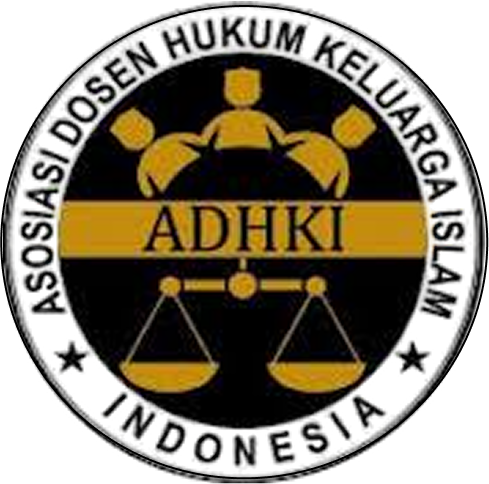Polygamy in Islamic Thought
Review and Bibliometric Analysis
DOI:
https://doi.org/10.22373/axgt7854Keywords:
Poligami, Islam, Analisis bibliometrik, VOSviewerAbstract
Abstract: Objective – Polygamy and Islam are significant topics to discuss along with the lack of research literature on polygamy in Islam in recent years. Therefore, this study aims to find out the current situation of research on polygamy in Islam supported by a bibliometric analysis of scientific publications indexed in the Scopus database.
Design/methodology/approach – This study applied bibliometric analysis using VOSviewer software to visualize the results of previous studies on polygamy in Islam indexed in the Scopus database from 1982-2022.
Findings –The findings of the bibliometric analysis showed that previous studies on polygamy in Islam based on the Scopus database indicated the tendency of rare attention of academics toward this topic. Therefore, in the future, such a topic has very broad opportunities that may focus on theoretical and empirical studies to improve science development.
Originality/value –This article is the first study to discuss polygamy in Islam through a bibliometric analysis approach. Thus, it is expected that this study has implications for future research trends by paying attention to variables that are still rarely investigated by academics.
Keywords- Polygamy, Islamic, Bibliometric analysis, VOSviewer
Abstrak: Tujuan – Poligami dan Islam merupakan topik signifikan untuk dibahas mengingat minimnya literatur penelitian mengenai poligami dalam Islam dalam beberapa tahun terakhir. Oleh karena itu, penelitian ini bertujuan untuk mengetahui situasi terkini penelitian tentang poligami dalam Islam yang didukung oleh analisis bibliometrik publikasi ilmiah yang diindeks dalam basis data Scopus.
Desain/metodologi/pendekatan – Penelitian ini menerapkan analisis bibliometrik menggunakan perangkat lunak VOSviewer untuk memvisualisasikan hasil-hasil penelitian sebelumnya tentang poligami dalam Islam yang diindeks dalam basis data Scopus dari tahun 1982-2022.
Temuan – Temuan dari analisis bibliometrik menunjukkan bahwa penelitian sebelumnya tentang poligami dalam Islam berdasarkan basis data Scopus menunjukkan kecenderungan minimnya perhatian akademisi terhadap topik ini. Oleh karena itu, di masa mendatang, topik ini memiliki
peluang yang sangat luas yang dapat berfokus pada studi teoretis dan empiris untuk meningkatkan pengembangan ilmu pengetahuan.
Orisinalitas/nilai – Artikel ini merupakan studi pertama yang membahas poligami dalam Islam melalui pendekatan analisis bibliometrik. Dengan demikian, diharapkan studi ini memiliki implikasi terhadap tren penelitian masa depan dengan memperhatikan variabel-variabel yang masih jarang diteliti oleh akademisi.
Kata kunci – Poligami, Islam, Analisis bibliometrik, VOSviewer
References
References
Al-Krenawi, A., Graham, J. R., & Al-Krenawi, S. Social work practice with polygamous families. Child and Adolescent Social Work Journal, 14(6), 445–458. https://doi.org/10.1023/A:1024571031073 (1997).
Al-krenawi, A., Graham, J. R., & Slonim-nevo, V. Mental health aspects of arab-israeli adolescents from polygamous versus monogamous families. Journal of Social Psychology, 142(4), 446–460. https://doi.org/10.1080/00224540209603911 (2002).
Alamgir, A. Islam and Polygamy: A Case Study in Malaysia. Procedia - Social and Behavioral Sciences, 114, 889–893. https://doi.org/10.1016/j.sbspro.2013.12.803 (2014)
Alamgir, A. Islam and Women’s Rights: Discourses in Malaysia. Procedia - Social and Behavioral Sciences, 114, 872–876. https://doi.org/10.1016/j.sbspro.2013.12.800 (2014).
Alhuzail, N. A. “I Wish he Were Dead.” The Experience of Loss among Young Arab-Bedouin Women in Polygamous Families. Affilia - Journal of Women and Social Work, 1–16. https://doi.org/10.1177/08861099221075899 (2022).
Ali, S. T. Feminism in Islam: A critique of polygamy in mariama ba’s epistolary novel so long a
letter. Hawwa, 10(3), 179–199. https://doi.org/10.1163/15692086-12341236 (2012) Alwi, B. M. Poligami dalam islam. Jurnal Ilmiah Al-Syir’ah, 11(1), 1–20. (2013).
Ambrus, A., Field, E., & Torero, M. Muslim family law, prenuptial agreements, and the emergence of dowry in Bangladesh. Quarterly Journal of Economics, 125(3), 1349–1397. https://doi.org/10.1162/qjec.2010.125.3.1349 (2010).
Azam, F. E., Rubab, I., Salahuddin, A., & Usman, A. Polygamy in Islam: Cultural Pressures and Religious Justifications in Pakistan. Islamic Thought and Civilization (JITC), 11(2), 246– 257, (2021).
Baker, H. K., Kumar, S., & Pattnaik, D. Fifty years of The Financial Review: A bibliometric overview. Financial Review, 55(1), 7–24. https://doi.org/10.1111/fire.12228 (2020).
Donthu, N., Kumar, S., Mukherjee, D., Pandey, N., & Marc, W. How to conduct a bibliometric analysis : An overview and guidelines. Journal of Business Research, 133(May), 285–296. https://doi.org/10.1016/j.jbusres.2021.04.070, (2021).
El Azayem, G. A., & Hedayat-Diba, Z. The Psychological Aspects of Islam: Basic Principles of Islam and Their Psychological Corollary. The International Journal for the Psychology of Religion, 4(1), 41–50. https://doi.org/10.1207/s15327582ijpr0401_6, (1994).
El Houssi, L. The role of women in Tunisia from Bourguiba to the promulgation of new constitution. Oriente Moderno, 98(2), 187–202. https://doi.org/10.1163/22138617-
, (2018).
Fenske, J. African polygamy: Past and present. Journal of Development Economics, 117, 58–73. https://doi.org/10.1016/j.jdeveco.2015.06.005, (2015).
Gruenbaum, E. The Islamic movement, development, and health education: Recent changes in the health of rural women in Central Sudan. Social Science and Medicine, 33(6), 637–645. https://doi.org/10.1016/0277-9536(91)90017-7, (1991).
Guirkinger, C., Gross, J., & Platteau, J. P. Are women emancipating? Evidence from marriage, divorce and remarriage in Rural Northern Burkina Faso☆. World Development, 146, 105512. https://doi.org/10.1016/j.worlddev.2021.105512 (2021).
Gureyev, V. N., & Mazov, N. A. Bibliometrics as a promising tool for solving publication ethics issues. Heliyon, 8(3), e09123. https://doi.org/10.1016/j.heliyon.2022.e09123 (2022).
Hassouneh-Phillips, D. Polygamy and wife abuse: a qualitative study of muslim women in America. Health Care for Woman International, 22(8), 735–748. https://doi.org/10.1080/073993301753339951, (2001).
Hussain, S. J. Legal Modernsim in Islam: Polygamy and Repudiation. Journal of the Indian Law Institute, 7(4), 384–398, (1965).
Kagimu, M., Marum, E., Wabwire-Mangen, F., Nakyanjo, N., Walakira, Y., & Hogle, J. Evaluation of the effectiveness of AIDS health education interventions in the Muslim community in Uganda. AIDS Education and Prevention, 10(3), 215–228, (1998).
Marzuki. Poligami Dalam Hukum Islam. Jurnal Civics Media Kajian Kewarganegaraan, 2(2), 1–10. (2005).
Mashhour, A. Islamic law and gender equality could there be a common ground?: A study of divorce and polygamy in sharia law and contemporary legislation in Tunisia and Egypt. Islamic Law in Practice, 3(2), 253–287. https://doi.org/10.4324/9781315251738, (2017).
Mongeon, P., & Paul-Hus, A. The journal coverage of Web of Science and Scopus: a comparative analysis. Scientometrics, 106(1), 213–228. https://doi.org/10.1007/s11192-015-1765-5,
(2016).
Nur Agustina, H. Tradition and belief in Kegelisahan Madu. In E3S Web of Conferences (Vol.
, pp. 1–5). https://doi.org/10.1051/e3sconf/202020207021, (2020).
Oakleaf, M. Writing information literacy assessment plans: A guide to best practice.
Communications in Information Literacy, 3(2), 80–90, (2009).
Okoli, C. A guide to conducting a standalone systematic literature review. Communications of the Association for Information Systems, 37(1), 879–910. https://doi.org/10.17705/1cais.03743, (2015).
Oppong, J. R. A Vulnerability Interpretation of the Geography of HIV/AIDS in Ghana, 1986– 1995*. The Professional Geographer, 50(April), 437–448, (1998).
Rehman, J. The sharia, islamic family laws and international human rights law: Examining the theory and practice of polygamy and talaq. International Journal of Law, Policy and the Family, 21(1), 108–127. https://doi.org/10.1093/lawfam/ebl023, (2007).
Ryazantsev, S. V., Pismennaya, E. E., Karabulatova, I. S., & Akramov, S. Y. Transformation of sexual and matrimonial behavior of tajik labour migrants in Russia. Asian Social Science,
(20), 174–183. https://doi.org/10.5539/ass.v10n20p174, (2014).
Sadat, A., & Ipandang, I. The Dynamics of Polygamy in the Middle of an Oligarchic-Patriarchal Culture (Study on the Poliwali Mandar and Konawe Communities of Sulawesi). Al-Manahij: Jurnal Kajian Hukum Islam, 14(1), 131–146. https://doi.org/10.24090/mnh.v14i1.3657, (2020).
Shukri, A. M., & Owoyemi, M. Y.. Sister in Islam’s quest for the reinterpretation of the Qur’an and Hadith: An analysis of their views on equality, women judges, and polygamy. Kajian Malaysia, 32(1), 55–80, (2014).
Strassmann, B. I., Kurapati, N. T., Hug, B. F., Burke, E. E., Gillespie, B. W., Karafet, T. M., & Hammer, M. F. Religion as a means to assure paternity. Proceedings of the National Academy of Sciences of the United States of America, 109(25), 9781–9785. https://doi.org/10.1073/pnas.1110442109, (2012).
Supraptiningsih, U., & Bariyyah, K. (2019). Marriage settlement among minority muslim by datok imam masjid in south thailand. Al-Ihkam: Jurnal Hukum Dan Pranata Sosial, 14(2), 221–235. https://doi.org/10.19105/al-lhkam.v14i2.2631, (2019).
Tarigan, A. A., Nurhayati, & Marpaung, W. TAMING ISLAM’S POLYGYNY LAW Revealing Male Sexual Desire in Indonesia’s Polygyny Practices. Journal of Indonesian Islam, 15(1), 149–170. https://doi.org/10.15642/JIIS.2021.15.1.149-170, (2021)
Tong, J. K. C., & Turner, B. S. (2008). Women, piety and practice: A study of women and religious practice in Malaysia. Contemporary Islam, 2(1), 41–59. https://doi.org/10.1007/s11562-007-0038-3, (2008)
Treister-Goltzman, Y., & Peleg, R. Urinary incontinence among Muslim women in Israel: risk factors and help-seeking behavior. International Urogynecology Journal, 29(4), 539–546. https://doi.org/10.1007/s00192-017-3438-9, (2018).
Published
Versions
- 2025-07-31 (6)
- 2025-07-31 (5)
- 2025-07-31 (4)
- 2025-07-31 (3)
- 2025-07-31 (2)
- 2025-07-31 (1)
Issue
Section
License
Copyright (c) 2025 Anwar - Sadat, Rahmin Talib Husain, Zumiyati Sanu Ibrahim, Muhammad Yusuf

This work is licensed under a Creative Commons Attribution-ShareAlike 4.0 International License.
Authors who publish in Samarah: Jurnal Hukum Keluarga dan Hukum Islam agree to the following terms:
- Authors retain copyright and grant the journal right of first publication with the work simultaneously licensed Attribution-ShareAlike 4.0 International (CC BY-SA 4.0) that allows others to share the work with an acknowledgment of the work's authorship and initial publication in this journal.
- Authors are able to enter into separate, additional contractual arrangements for the non-exclusive distribution of the journal's published version of the work (e.g., post it to an institutional repository or publish it in a book), with an acknowledgment of its initial publication in this journal.
- Authors are permitted and encouraged to post their work online (e.g., in institutional repositories or on their website) prior to and during the submission process, as it can lead to productive exchanges, as well as earlier and greater citation of published work. (See The Effect of Open Acces)









